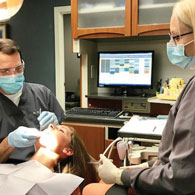Dentist brings oral health best practices to rural community
After W. Scott Garris earned his Doctor of Dental Medicine degree from the Medical University of South Carolina (MUSC) in 1999, he jumped at the chance to purchase a dental practice in St. George, S.C. “I grew up in this community, and that gives me a genuine interest in the care of its people,” Garris says. “I was delighted to be able to return here to practice dentistry.”

Garris soon grew and modernized the practice, adding new technology and moving into a state-of-the-art facility. He then opened a second location about 20 miles away in Santee, a town with similar demographics — rural, elderly, less privileged patients.
In 18 years, he’s built his practice into a three-dentist, five-hygienist group.
“Dr. Garris abides by the guidelines of our state practice act with regard to how dentists can use and supervise dental hygienists, but ultimately uses his hygiene staff very effectively,” notes Amy Martin, DrPH, MUSC Division of Population Oral Health director. “It helps provide access to care for underserved communities.”
Connecting oral health and general health
Many of Garris’ adult patients have underlying, systemic health issues such as diabetes, heart disease or hypertension. “It’s critical for people with health issues to receive periodontal care,” Garris says. Because when they don’t, they can suffer rapid bone loss and loss of teeth. Then, it’s a domino effect: Their dietary choices become more limited, and they tend to eat more processed foods and not as many fruits, vegetables and meats. That means more calories, extra weight and poor nutrition. Those factors, in turn, exacerbate their diabetes, hypertension, heart disease and other health issues.
Maintaining financial viability
As with any low-income population, the costs of periodontal care can be an issue. “We emphasize to our patients the importance of good oral health to overall health,” Garris says. “If our patients value our recommendations and accept treatment, they generally find a way to afford it to put themselves in a better state of health.”
The practice provides discounts for cash payments and uninsured patients. Garris markets the practice with social media and uses patient-centered promotions and giveaways to build business. The practice’s website contains a wealth of educational materials to help patients understand the importance of oral health.
“We focus our practice on good oral hygiene instruction for patients,” Garris says. “And we encourage them to have three-month maintenance visits and scaling and root planing.”

Partnering with primary care providers
Currently, Garris is developing a medical-dental referral network with a health center in Santee. “Dr. Garris helps primary care providers understand how he might be able to help them obtain the quality measures they’re seeking with their patients,” Martin notes.
She advises other rural dentists trying to establish referral networks with primary care providers to seek out those affiliated with a hospital or health system, since they tend to have more of the necessary technology resources at their disposal.
“We’re exploring how dental and primary care providers can work together on high priority target populations,” Martin says.
The DentaQuest Foundation, which has recently partnered with the National Rural Health Association on its National Rural Oral Health Initiative, provides a blueprint for how to make the case for primary care to be involved in oral health as part of chronic disease management.
Those methods include:
- People with diabetes: “With diabetic patients, you’re not going to be as successful in managing blood glucose levels if they’re not connected to dental care,” Martin notes.
- Pregnant women: “Preterm labor is associated with unmanaged gingivitis and periodontal infection,” Martin says.
- People with HIV: “These patients are completely dependent on compliance with their pharmaceutical regime, which only works if they eat, so they need healthy teeth,” Martin adds.
What’s in store for the future?
“As we move into a value-based purchasing environment, it’s going to be even more important that we have reimbursement policies and fee schedules that are in alignment with evidence-based practice,” Martin says. Learn more about NRHA’s National Rural Oral Health Initiative at www.ruralhealthweb.org/ROHI.
